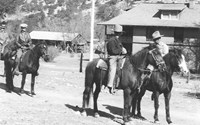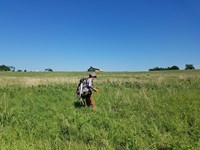Specific Homes
- Cuyahoga Valley National Park
Frazee House Panel
- John Muir National Historic Site
Stop 2: John Muir in Martinez
- John Muir National Historic Site
Stop 5: Ranch Labor
- Cuyahoga Valley National Park
Stanford Trailhead
- Locations: Cuyahoga Valley National Park
- Mesa Verde National Park
Hemenway House Overlook
- Chiricahua National Monument
Faraway Ranch
- Mesa Verde National Park
Cliff Palace Loop Road
- Mesa Verde National Park
Cliff Palace Overlook
- Locations: Mesa Verde National Park

Cliff Palace Overlook is a magnificent view point for Cliff Palace, the largest cliff dwelling in the park. With at least 150 rooms and 21 kivas, Cliff Palace is an exceptionally large cliff dwelling and possibly an important gathering place as an administrative center with ceremonial use for many nearby Ancestral Pueblo villages.
- Fort Smith National Historic Site
Fort Smith Commissary
- Locations: Captain John Smith Chesapeake National Historic Trail, Chesapeake Bay
- Offices: National Register of Historic Places Program

Machicomoco State Park, located on the York River, is dedicated to telling the story of Virginia's Indigenous peoples. Its name, Machicomoco, means "a special meeting place" in the Virginia Algonquian language. At the park, miles of trails, a fishing pier, a paddle craft launch, and campground sites offer many ways to recreate at the park. Visit the interpretive area to learn more about Native American culture and history.
Stories About Homes
- Eisenhower National Historic Site
"It is the only home, truly ours": Making the Eisenhower Home a National Historic Site
- Locations: Carter G. Woodson Home National Historic Site
- Offices: National Historic Landmarks Program

Carter G. Woodson’s best-known contribution occurs every February. He initiated celebration of the first Negro History Week in 1926, focusing on black history. Woodson chose the second week of February for Negro History Week because it corresponds with the birthdays of both Frederick Douglass and Abraham Lincoln. Over the years, support grew, and the week became a month in 1976. February of each year is now Black History Month.
- Homestead National Historical Park
Bird Community Monitoring at Homestead National Historical Park
- Homestead National Historical Park
Vegetation Community Monitoring at Homestead National Historical Park
- Locations: Homestead National Historical Park
- Offices: Heartland Inventory & Monitoring Network

Birds are excellent indicators of environmental change in ecosystems. The woodland and restored prairie habitat at Homestead National Historical Park supports a wide array of bird species. The Heartland Inventory and Monitoring Network monitors birds on the park to understand how the bird community is doing and how birds respond to changes in their habitat. Bell's Vireo and Red-headed Woodpecker are species of concern in the region.
- Heritage Documentation Programs
The Historic American Buildings Survey's 90th Anniversary
- Offices: Heritage Documentation Programs

In celebration of the 90th anniversary, on 11-10-23, an exhibition opened at The Athenaeum of Philadelphia titled “Blazing the Trail: The Historic American Buildings Survey turns 90.” The exhibition highlights the past decade of HABS projects and the use of emerging technologies that place HABS on the forefront of architectural documentation practice. Each project represents different challenges and applications to best suit the resource. Here is a summary of the project.
- Locations: Herbert Hoover National Historic Site, Homestead National Historical Park, Pipestone National Monument
- Offices: Heartland Inventory & Monitoring Network

Herbert Hoover National Historic Site, Homestead National Historical Park, and Pipestone National Monument all protect tallgrass prairie communities. We monitor the plants in these parks to understand how the prairies may be changing over time. Analyzing data from all three parks together helps managers understand how similar management actions at other parks are affecting prairie maintenance. Pipestone National Monument prairies have some unique geology that makes the plant
- Locations: Gateway Arch National Park
- Offices: National Center for Preservation Technology and Training

This multiple property context examines the advent of Mid-century Modernism and how it resulted in the iconic Ranch form in Arkansas during the period from 1945 to 1970. I outline the convergence of Modernism and the popular Ranch form by examining the bureaucratic, social, cultural and economic factors that contributed to significant transformations in domestic architecture.
Last updated: July 28, 2023













